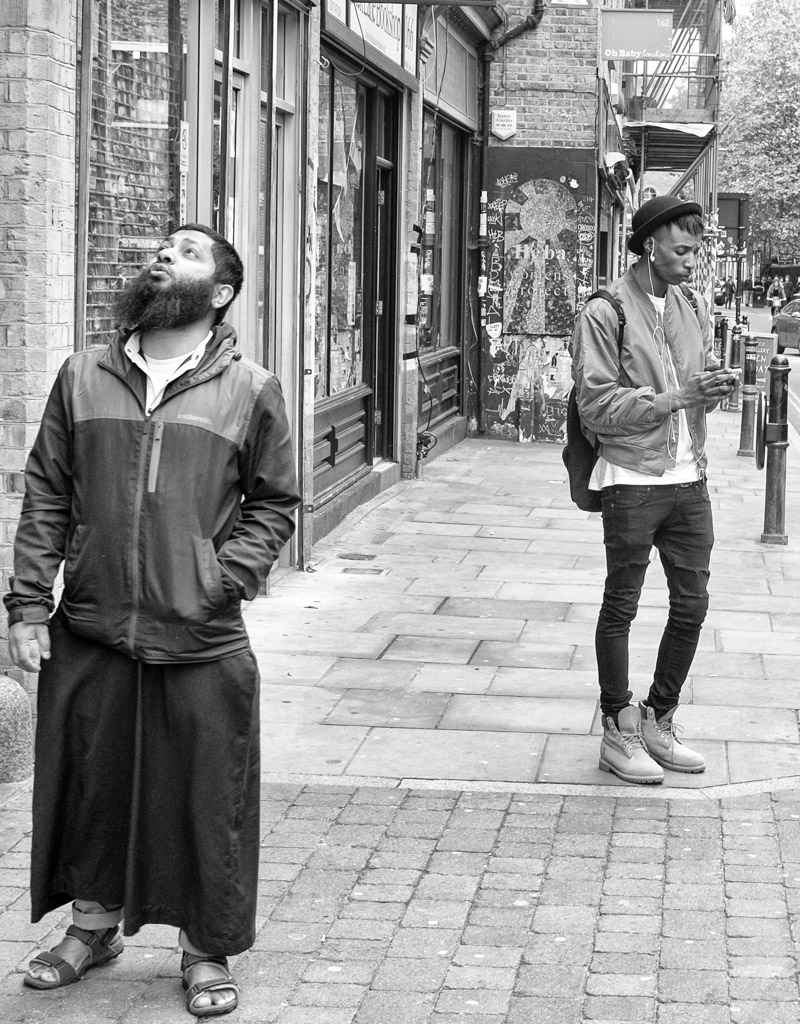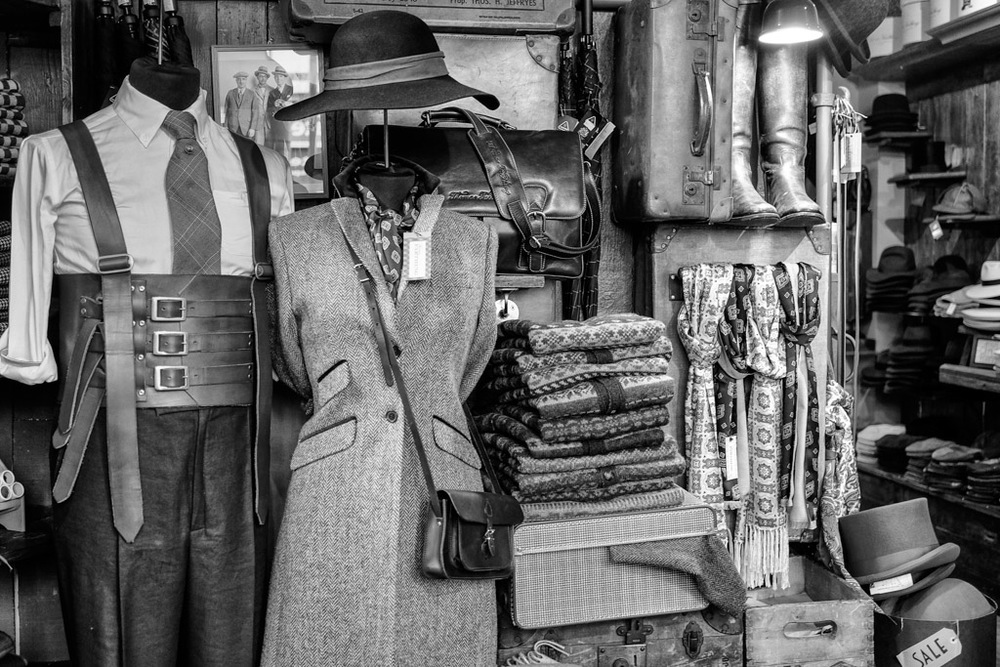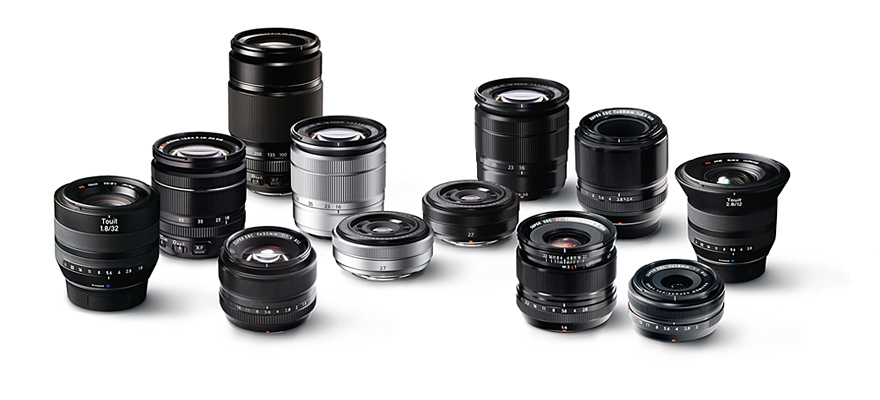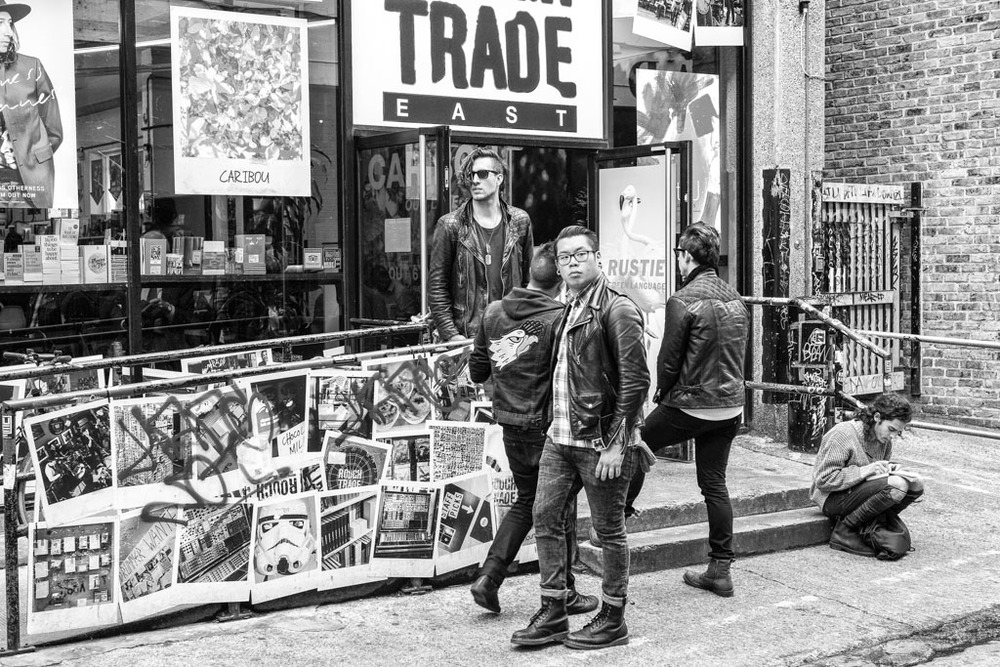
Currently I’m putting Fuji’s highly acclaimed X-T1 through its paces. It came with the standard 18-55 zoom but I have managed to borrow a remarkable little pancake, the 27mm f/2.8. I reckon it is just about the bee’s knees when it comes to street photography.
My first question, though, is how this combination compares with the lionised X100/S/T, the camera that started Fuji on to X series road in 2010. It seems incredible now that we have seen the X cameras spawn like crazy from such a simple beginning. But, more important, Fuji has launched perhaps the most comprehensive array of pro-quality lenses ever seen in such a short period.
The X100 range with its 35mm-equivalent fixed focal length and ingenious hybrid viewfinder has rightly won its place high on the list of streettog desirables. This little Leica M3 lookalike is probably the most popular go-to camera for street enthusiasts.

Different market

The new X-T1 is aimed at a different market. Instead of fixed-lens simplicity it offers a first-class ticket to the wonderful world of Fujinon XF glass. The original 18-55 zoom and that sharp, Summilux-challenging 35mm f/1.4 are still going strong and are as popular as ever. But the range has been expanded with some great prime lenses such as the 23mm f/1.4 and the new 56mm f/1.2 APD, a portrait-painter’s delight.
While the spotlight isn’t so accurately focused on the cute little 27mm f/2.8, this aspherical lens has carved a solid reputation as a versatile optic for the X-series ILCs. For me, it has an overriding benefit in its 27mm focal length which is equivalent to full-frame 41mm.
Click here to read more camera tests by Macfilos
As the holder of a Masters in vacillation, I appreciate this mid-point between the twin holies of 35mm and 50mm. Popular prejudice among streettogs runs to a wide thirty five. But I have recently tended towards the longer nifty fifty. So, here, in one diminutive package, we have the vacillator’s dream come true. I approach it with the same reverence that experienced Leica owners have for the tiny 40mm Leica Summicron-C made for the defunct C and CLE cameras back in the ’70s. It lost its popularity post-C because M cameras lack 40mm framelines but I can see a resurrection now EVF use is possible.

Street at f/8
For street photography I don’t miss the brighter F/2 of the X100 family; f/2.8 is more than fast enough and, truth be told, most street work is done between 5.6 and 8. The little 27mm is therefore just about perfect.
As a package, the X-T1 and 27mm rivals the new X100T. At 530g it is only 90g heavier than the fixed-lens camera and the small added bulk makes it more sure in the hands, especially with the benefit of that generous grip. Together with a wrist strap, I find the X-T1 combo easier to manage than the X100.
The X-T1 offers a wider range of manual controls, including direct dial access to ISO, but the 27mm lens loses out to the X100 in not having a manual aperture ring. It is a small compromise, however.

Viewfinders
Viewfinder spec is the first big difference between the two cameras. The X-T1 has the brightest and biggest mirrorless-camera EVF in the business. It is superb and is particularly suited to manual focus. On the other hand, the X100T compensates for its smaller and more discreet EVF by providing an ingenious hybrid optical/electronic view. Having tried both, I came to the conclusion that the optical finder in the X100 is a distraction. I soon reverted to the electronic view. The EVF is all I need and, with this in mind, the X-T1 wins hands down. It also has the big advantage of a tilting screen which is useful for low-down shots. I will offer one proviso. If you have never used a rangefinder such as that on Leica’s M you will tarry a while with the X100’s optical finder and be intrigued. If, on the other hand, you are used to a Leica you cannot help but be disappointed and will soon be glued to the EVF.

The second big difference is the obvious one: Fixed lens versus interchangeable lenses. While the XT-1 and 27mm does a sterling job of matching the X100T feature for feature and heft for heft, it has the overriding advantage of flexibility.
Not only can you turn your minimal street camera into a fine portrait device or, even, a passable sports capture instrument, you have at your disposal one of the best ranges of lenses on the market. If you wish, also, you can access almost all Leica, Zeiss and Voigtländer manual M-mount lenses made in the past 50 or 60 years (using the optional adapter, of course).
Verdict
Yes, I do believe the X-T1 with a suitable lens is as good as the X100T for street photography. As part of an overall system it beats the fixed-lens camera in practicality. If, however, you own an ILC with a range of lenses you will enjoy the X100T as a handy second camera. In the final analysis the choice is down to you.
Since the firmware update in late December 2014 I have had further thoughts on these two cameras, also bringing the X-E2 into the equation:
Read the full story here

Fuji camera and lenses loaned by Chiswick Camera Centre, London
And now for something different:
Here is another picture taken at the same time in the same location, Brick Lane. But there is a big difference. This one was taken with Leica’s new M-P and a sharp 50mm Summilux M. Like the Fuji, the M-P was set to a slow aperture (in this case f/7.1) and 1/125s to avoid shake. I leave the verdict to you. But this combo costs £9,200 compared with the Fuji and 27mm at around £1,250. It is also twice as heavy because, verily, it is built like a brick outhouse.
Postsript (23/11/2014): Eric Kim has been testing the X100T as a street camera and concludes that it is marginally better at the job than the X-T1. Read his full article here


so timely and well done. I am a x100 user which is my only digital in addition to a M6 for film and a 35/50mm Cron. Ive been waiting for the XPro II announcement (like us all) so I can use my Leica glass/fuji glass for street and other fine art related photography. BUT I’ve been seriously looking at the x100T while waiting which initiated the thought of: the x100t vs XT1. Your piece really hit it on the head and very cool idea of the 27mm pancake… nice work! your blog is now book marked!-Daniel
Thanks, Daniel, glad to be of help. I am currently reviewing the X100T. As a dedicated fixed-lens camera for street work it is near ideal, but only if you are happy with the 35mm focal length. The X-T1 and 27mm pancake, on the other hand, is not much bigger or heavier, produces comparable results and is actually easier to hold firmly thanks to the bigger grip. And I still prefer the equivalent 41mm focal length–perfect for those, like me, who can never decided whether they prefer 35mm or 50mm. My original advice holds good: Go for the X100T if you do not need the flexibility of different focal lengths–or already own a different ILC. On the other hand, if you want just one camera, the X-T1 is the better choice.
The hybrid viewfinder, which is the main differentiation between the two cameras in practice, is something I can live without. The extra-large finder of the X-T1 is more than adequate compensation.
Thanks for this concise little write up about the two Fuji cameras. I am one of the many, I’m sure, who is switching from Nikon to Fuji. Also on a one camera budget (for now) the decision is a fun but important one for me. Thanks for shedding some well written light on the topic.
Many thanks for your email and I am glad you liked the story on the two Fujis. I too went through a long period with heavy DSLR kit but gave it all up a few years go in favour of mirrorless, eventually working my way to Leica. Now I am interested in the Fuji range in particular because of the great results, not to mention the line-up of lenses.
For a one-camera choice I think the X100T, excellent as it is, is too limiting. If you like the size and form factor of the X100 then the obvious choice is the X-E2 which gives comparable results to both the X100 and X-T1. The X-T1, on the other hand, is more DSLR-like and, probably, more familiar territory for an experienced large-systems photographer.
I will be interested to have your conclusions when you have reached them.
Thanks. On reflection you are probably right that the X-E1 is a closer comparison. It’s just that I had the X-T1 in hand and was impressed by its street competence.
Interesting story. I’ve used both Leica and Fuji and own the 35mm Fujinon as well as a 50mm Summilux. I am hard pressed to tell the difference from the results of these two lenses despite the vast gulf in price. Last time I looked the Leica lens was £3,000 while the Fuji equivalent can be had for £300 after the current cashback offer. It’s remarkable really and I think Fuji have done a great job in putting lens technology at the heart of their system. No point in having brilliant cameras (Sony A7 I’m looking at you) if there isn’t an equally brilliant range of lenses to go with it. Back to the XT-1, I agree it can be a great street camera with that 27mm lens (or the excellent 18mm) but I would have thought that the equally competent X-E2 would have made a better comparison with the X100 because it is nearer the size and has the "rangefinder" format. Just my opinion but a great story, thanks
I really like the top shot of the two guys seeking inspiration. If one is looking for God the other is seeking Mammon! Nice juxtaposition and well seen.
Mike, thanks for the thoughtful response. I know exactly what you mean about viewfinder-less cameras. Not my preference, but… I make exceptions for the X-M1 and particularly the GR because their small size means they "Get away with it". That said, a couple of years ago I shot quite a bit with a D-Lux 4 with a SBOOI 50mm external ‘finder. I’m contemplating doing the same with the X-M…
I do counsel you to have another look at the X-M in particular – I snagged one first of all as a cheap backup to my original X-E1. When that was replaced by an X-Pro and that in turn was joined by an X-T, having the X-M as well felt a little over-the-top, so I sold it on. A few months down the line I have another, but now that 27mm is welded to it, and it has become my "I’m not carrying a big camera today, honestly…" solution. It is limited, true, but so handy that it has carved a niche of it’s own in my usage.
Tell you what, I’ll let you off "streettog" (which my autocorrect persists in converting to "streetlights") if you separate the two Ts with a hyphen ;0)
Bill,
That’s very civil of you on the question of street-tog. I agree, the double T is a distraction but I don’t think Eric sees it thus.
I will certainly have a look at the X-M if I do decide to buy a Fuji (the current crop of stuff is on loan). I was taken with the Canon EOS M a couple of months ago, despite the lack of the viewfinder, mainly because of the touch-focus-shoot facility. I will look at the X-M and give my verdict.
I have to say I am so impressed with the XT-1 that I am likely to take the desperate step of actually buying on. It has fantastic built quality and everything works so well. I also don’t dislike the mini SLR styling which is perhaps a refreshing challenge to the Leica rangefinder style we have seen in so many mirrorless cameras–including, of course, the M3 lookalike X100T.
If you are splashing the cash on one X Series body then I’d agree that the X-T1 is the current cream of the crop. An A or an M is okay per se but too limited for 24-7 use, particularly with no vf. If I was buying into the system this morning I would personally start with an X-E2 – great spec. for the money. Or you could score a refurbished X-Pro1 on Fuji UK’s own site. But given your expressed preference for an SLR form factor the T is your friend. Resistance is futile… ;0)
But you are quite right. I could just has easily have made a strong, perhaps even stronger, case for the X-E2 which is arguably more comparable with the X100, if only in size and form. I have no particular preference for the DSLR format although I do think the X-T1 looks extremely cute with its retro image. Again, though, the X-T1, with its grip and comfortable handling, is the better system camera. For a one-body photographer, the T1 ticks so many boxes that it really stands out.
Dear Bill,
Thank you for your input, constructive as always. I had considered mentioning other cameras in the X range but I decided against. Since the instigator of the article, the X-T1, was in my hands and is the most compelling APS-C system camera on the current market (the X-Pro notwithstanding) it was a natural choice.
Perhaps I was wrong because, as you say, other X cameras, such as the X-E1 and X-E2, make a good case for the creation of a small street outfit to rival the X100. The X-A and X-M were not on my radar because of the lack of viewfinder which is a personal foible of mine. For the same reason I discount the Ricoh GR, excellent as it is in all other respects. I confess, however, I have not looked closely at the X-A and X-M and I will bow to your endorsement.
As for "streettog", I suspect this is a matter of personal preference. While I tend to take a similar view to yours on many a new coinage, this is one that rather amuses me. I associate it more with Eric Kim (who I am fairly certain invented it) in a positive way. He is neither old geezer nor a hooded hooligan but streettog rolls smoothly off his tongue.So it doesn’t have the same downmarket connotations in my fevered imaginings.
I do rather like it and feel that it is a welcome alternative to the staid term "street photograper". However, you will be glad to hear I have not yet progressed (or regressed) to streettoger, strettogery or streettoging. But watch this space after I’ve decided whether there should be one or two Gs. I do, however, understand your point of view. In the past twenty years I have objected to new words such as email, text (as a verb), tweet, ebook and app but have eventually come to accept them. I can’t guarantee streettog will become as universal because, after all, it is a minority interest. I will just have to remember not to utter it in your presence when next we meet.
Hi Mike, good write-up but I think you miss a couple of points, and fall into the trap of comparing apples and asparagus…
Firstly, the 27mm is indeed a superb lens for street photography but the X-T1 isn’t the ideal platform for it. There are better suited cameras in the Fuji line-up including the X-Pro (of course) and the X-A and X-M. Mounted to either of the latter two bodies you have a viable rival to the Ricoh GR – I know because I have both. Stick the 27 to the front of an X-M with the OEM grip and a lensmate thumb-rest and you have a formidable, fast handling and compact picture-taking machine, particularly when zone-focussing. If I were setting out to do street photography – as I am today – I would leave the X-T at home – as I have – and bring the X-M – as I have – to benefit from the smaller size body built around the self-same sensor. In doing so you are closer in handling and in spirit to using a Leica CL with the 40mm Summicron (or the Minolta CLE) than an M.
Secondly, the Fuji is not a Leica – and it does not need to be. I have "done" Leica for 20 years and can safely say that a Leica M – a proper one – is a superlative picture-collecting tool with superlative glass – but it is not the sine qua non it once was. I keep an M2 (and a IID) for the tactile pleasure of using them – but when I want to be sure of the shot, I reach for a Fuji…
Finally, a personal plea… PLEASE don’t persist in using the term "streettogs" – it is a linguistic crime, like ragged fingernails on a fresh blackboard and conjures up all the wrong images, from cheap heavily-logo’d hoodies to "Terry’s Old Geezers" – If anyone used it to my face they would find themselves wearing an X-series body in short order… ;0)
It’s almost impossible to judge the difference in IQ when viewed on a laptop screen. To really see the difference, images should be looked at in print, then the difference should become apparent.
I’ve been shooting with a xt-1 + fujinon 35mm 1.4 and been loving it. The only thing that I feel could be substantially improved is the manual focus hardware; I recently tried a Leica lens and the infinite focus ring of the fujinon is nowhere near as good (and at 1.4 and with low light the autofocus often isn’t quick enough…). I look forward to hearing your thoughts on using the xt-1 + Leica lenses, who knows, that might lead me to change the 35mm fujinon for a 35mm summilux 🙂
Hi Arturo. Of course you are right. Manual focus with automatic lenses (not just Fujinons) is a royal pain. That focus ring just goes round and round and demonstrates the disadvantages of fly by wire.
Manual focus lenses such as the Leica Ms, are bother matter. The tight 49-degree throw is more like the steering wheel of of a racing car. Quick and precise.
In general, it is fun to use manual focus on a Fuji or Sony but very little fun to do so with a native autofocus lens. As a regular rangefinder user I have no desire to use manual focus on the Fuji lenses. Better to mount a Leica.
What;s brick lane?
Brick Lane is a street market in East London which runs north from near Aldgate East Underground station. It is a very multicultural area and attracts street photographers like a magnet. Sunday is the best day for crowds but some of the best opportunities occur mid week.
I have the XT-1 and the 27 mm lens but can’t get the same results. What appliction you using to process. Lightroom?
I do use Lightroom but all these shots were converted in Silver Efex Pro which is my favourite PP app for black and white.
Re the Leica picture. I think it does have the edge but so it should at the price. The Fuji shots are near as dammit as good IMHO
You talk about the X100T but do not mention the new split image viewfinder option. Surely this makes the T a better bet than the XT1 or the overpriced Leica
In the past I have owned both the X100 and X100S. I had a brief chance to try the X100T at Photokina but wasn’t very impressed with the split-image. I seem to remember this was also on the S but I could be mistaken. Anyway, it isn’t a Leica rangefinder competitor and, frankly, I prefer using the EVF. The Leica rangefinder is so good that it offers a very good reason to use a Leica rather than any other camera. I suspect it is nigh on impossible to reproduce electronically what happens mechanically with the Leica system. After 60 years it still hasn’t been beaten I think.